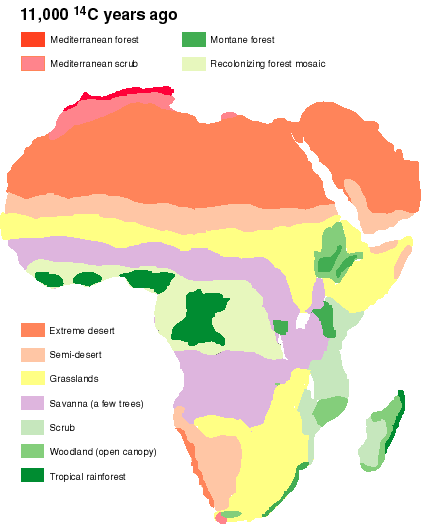
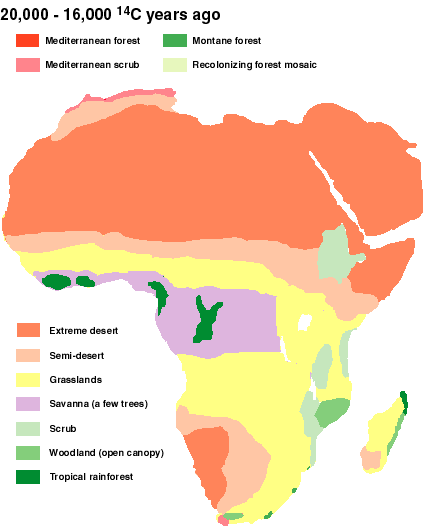
Africa 11 thousand years ago:

Africa 09 thousand years ago:
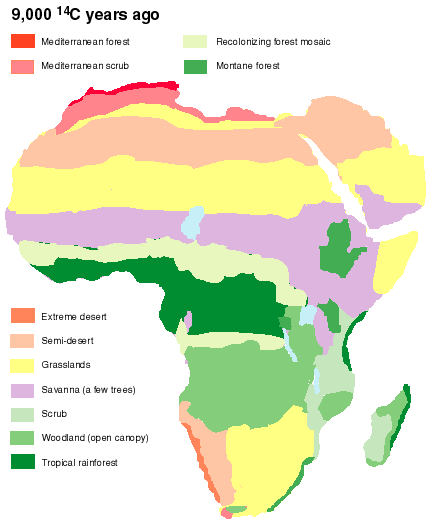
Africa 05 thousand years ago:
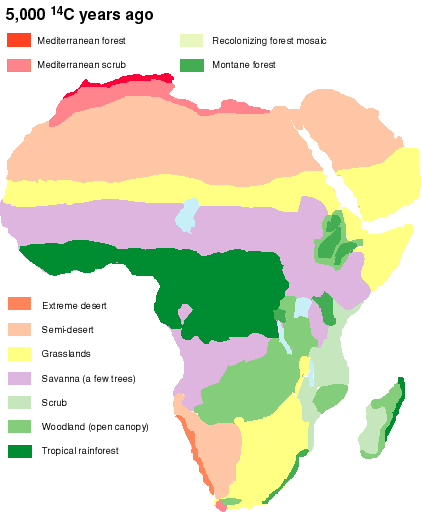
Africa currently
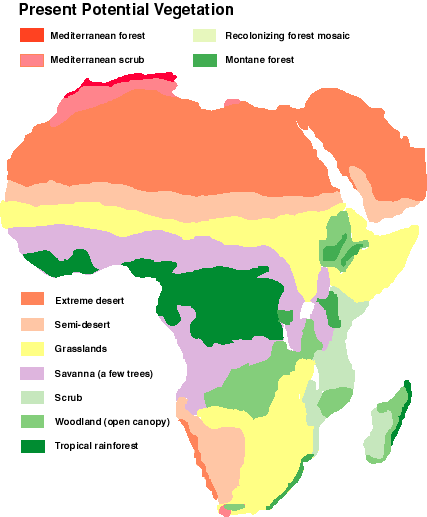
From around 150,000 to 130,000 years ago, Africa experienced colder and more arid than present conditions. About
130,000 years ago, a warm phase moister than the present began, and this lasted until about 115,000 years ago, with
greater rainforest extent and the deserts almost completely covered with vegetation. Subsequent cooling and drying
of the climate led to a cold, arid maximum about 70,000 years ago, followed by a slight moderation of climate and
then a second aridity maximum around 22,000-13,000 14C years ago. Conditions then quickly became warmer and moister,
though with an interruption by aridity around 11,000 14C years ago. A resumption of warm, moist conditions led up to
the Holocene 'optimum' of greater rainforest extent and vegetation covering the Sahara. Conditions then became
somewhat more arid and similar to the present. Relatively brief arid phases (e.g. 8,200 14C y.a.) appear to
punctuate the generally moister early and mid Holocene conditions.
Observe that grassland stretches from west coast to east coast, always has. The latitude and extent of it expands and contracts as the climate cycles over and again thru wet and dry phases, but east and west Africa have never been substantially cut off from one another.
[This message has been edited by rasol (edited 14 March 2005).]
quote:
From around 150,000 to 130,000 years ago, Africa experienced colder and more arid than present conditions.
[This message has been edited by Super car (edited 15 March 2005).]
quote:
Originally posted by Super car:
Earlier it was thought that Homo Sapiens Sapiens appeared around 150, 000 years ago. Further studies show that they may well have been around 200,000 years ago. In light of what you posted earlier (provided below), what should be said about the climatic conditions during 200,000 years and how this affects the evolutionary process of humans?
What should be said is that climate varies everywhere and the variations involve many complex interrelated cycles, which are in turn related to ocean currents, orbital axes variation, release of carbon dioxide from volcanos and many other phenomena.
However, tropical regions such as Africa do not vary as wildly over time as do northerly climes such as North America or Europe.
Europe and North America vacilate between being largely ice covered wastelands to milder more temperate zones.
Africa varies largey in that the deserts, grasslands and rainforests spread, and retreat, with human populations expanding and retreating along with it. During the last wet phase about 10,000 years ago much of the sahara was fertile, with crocodiles, giraffes, lakes and substantial human populations as well.
The drying of this area is likely one of the factors that caused populations to converge into the Nile Valley and also expand across the Levant. Populations in Africa respond to climate change primarily by migrating.
The precursors of the indigenous somatic variations that exist in Africa today have existed for many 10's of thousands of years because the same range of climate variation has exited during this time, and repeated over and again. And of course this is notwithstanding the climatic constant of tropical solar radiation, to which native African dark skin tone is adapted.
The situation in Europe could not be more different....
About 24,000 years ago, the last ice age began, with mountain-sized glaciers moving across most of Europe. Paleolithic Europeans retreated before the ice, finding refuge for hundreds of generations in three areas: what is now Spain, the Balkans and the Ukraine. - PA Underhill.
[This message has been edited by rasol (edited 15 March 2005).]
There are 3 principal factors directly effecting the amount of energy the earth gets from the sun. The solar cycle, orbital eccentricity and, perhaps the most important... orbital tilt.

The greater the tilt in the Earth's axis.....the MORE solar energy is received in the mid and high latitudes....and less (than usual) is received in the tropical and equatoral regions.
The smaller the tilt in the Earth's axis...the more solar energy is received in TROPICS, and less in the mid and high latitudes.
It is this condition that is one of many interrelated culprits in triggering ICE AGES.
25 thousand years ago the Earth's axis tilt was near it's minimum. This means Northern EurAsia may have recieved less UV at this time, but tropical East Africa may have actualy recieved more.
Pale skin tones developed in Eurasia at around this time. In tropical Africa, pale skin is and always has been maladaptive (ie = skin cancer).
Native tropical Africans have dark skin for this reason and always have- throughout the entire history of modern human evolution from 150kbp until today.
Apehelion - when the earth is furthest from the sun.
Perhelion - when the earth is closest to the sun.
Presently the perhelion occurs in January and apehelion in July. To those living in the Northern Hemisphere this may seem odd, but this actually makes the seasonal extremes in the Northern Hemisphere less severe and those in the Southern Hemisphere more severe.
10 thousand years ago, the reverse was the case, 20 thousand years ago, it was as it is now.

Each of these phenomena have a different time scale and so a complex relationship on the earth's climate, often effecting the northern vs. southern hemishere and the topics vs. the high latitudes, in opposite ways, and with a minimal effect on actual UV sometimes having a major impact on climate especially in Northern Eurasia.
Africa's native peoples are primarily adapted to a high UV environment with differing ranges of savanna grassland, desert and rainforest.
[This message has been edited by rasol (edited 16 March 2005).]
What is now the sahel zone, the present climatic abode of peoples such as the Taureg and Fulani, made up almost the entirety of the Northernmost regions of the continent, and true Sahara, essentially ceased to exist, and sub-sahara during this formative period for African culture is somewhat of a misnomer.

Stop around lunchtime at Dabos to see the stunning, almost life size, recently discovered neolithic rock engraving of a giraffe. Rock engravings and paintings in this part of the Sahara date as early as 8-6,000BC. The giraffe at Dabos is another testimony that the Sahara was once wet and green http://www.exploreafrica.net
[This message has been edited by rasol (edited 20 March 2005).]
quote:
Originally posted by rasol:
Observe that grassland stretches from west coast to east coast, always has. The latitude and extent of it expands and contracts as the climate cycles over and again thru wet and dry phases, but east and west Africa have never been substantially cut off from one another.[This message has been edited by rasol (edited 14 March 2005).]
Thank you for making this point. I am always somewhat amazed by the fact that people believe that africans cannot now or could not then travel long distances or traverse hostile terrain of their own volition.
quote:
Originally posted by kifaru:
Thank you for making this point. I am always somewhat amazed by the fact that people believe that africans cannot now or could not then travel long distances or traverse hostile terrain of their own volition.
It is also interesting to consider, in terms of defining Africa by geography and then by ethnicity....where exacty does East Africa end and west Africa begin, and why...based on what geographic feature, cultural facet, genotype or physical feature?
In truth you are likely to find affinity on all fronts from East to West for reasons shown on the above climate maps.
However since anthropology revealed the rift valley origins of humanity, the tendency has been to attempt to remove East Africa...from Africa.
And many misguided studies on Africa and its peoples have, by design, and consciously or not, tended to conceptually replicate that ideological bias.
quote:
Originally posted by rasol:
AFRICA:The Fertile Valleys of the Nile, Indus, Tigris, Euphrates, and Yellow rivers were able to support large populations and it was here that great 'civilisations' of the Ancient world emerged
more...
Thought Posts:
http://www.cru.uea.ac.uk/~e118/publications/Brooks-BeyondCollapse-abs.pdf
quote:
Originally posted by rasol:
Thought Posts:
http://www.cru.uea.ac.uk/~e118/publications/Brooks-BeyondCollapse-abs.pdf
Thought Writes:
The important thing about this study is that it demonstrates the flaws in the "agricultural revolution" theory as espoused by Gordan Childe. Childe argued that agriculture and animal husbandry led to sedentism and sedentism led to an urban revolution. This urban revolution in turn led to social complexity or "civilization". Of course we now know that some groups like Africans in Early Khartoum have been sedentary since the early Holocene but did not develop hierarchical complex political structures. Likewise central and northern Europeans practiced village based agriculture earlier than Africans outside the Nile Valley, yet they NEVER developed hierarchical complex political structures they simply received these structures from Rome. Populations in the Saharan Neolithic practiced a semi-sedentary wild grain using transhumance based lifestyle, yet they also developed hierarchical complex political structures as evidenced by the burial of elites throughout the Sahara. This political substructure was infused and elaborated on in Ancient Egypt. The key seems to be economies based upon agriculture and/or animal husbandry effected by extreme environmental constraints. Agriculture and/or animal husbandry produce unequal wealth accumulation. Environmental stress adds hierarchical complexity to this economic and political structure.
...What about what Europe was like during corresponding periods?
quote:
Originally posted by Thought2:
Thought Writes:
Of course we now know that some groups like Africans in Early Khartoum have been sedentary since the early Holocene but did not develop hierarchical complex political structures.
??
[This message has been edited by Super car (edited 27 March 2005).]
About 24,000 years ago, the last ice age began, with mountain-sized glaciers moving across most of Europe. Underhill said the Paleolithic Europeans retreated before the ice, finding refuge for hundreds of generations in three areas: what is now Spain, the Balkans and the Ukraine.
When the glaciers melted, about 16,000 years ago, the Paleolithic tribes resettled the rest of Europe. Y chromosome mutations occurred among people in each of the ice age refuges, said Underhill. He said the research shows a pattern that developed in Spain is now most common in northwest Europe, while the Ukraine pattern is mostly in Eastern Europe and the Balkan pattern is most common in Central Europe.
About 8,000 years ago, said Underhill, a more advanced people, the Neolithic, migrated to Europe from the Middle East, bringing with them a new Y chromosome pattern* and a new way of life: agriculture. About 20 percent of Europeans now have the Y chromosome pattern from this migration, he said.
In general, studies show that modern humans first arose in Africa about 100,000 years ago and thousands of years later began a long series of migrations, he said. Some groups migrated eastward and humans are known to have existed in Australia about 60,000 years ago. Other groups crossed the land bridge into the Middle East. Humans appeared in Central Asia about 50,000 years ago. From there, the theory goes, some migrated west, arriving in Europe about 40,000 years ago
- Early Europeans, 11-2000 AP
quote:
Originally posted by windstorm2005:
Excellent thread!...What about what Europe was like during corresponding periods?
Thought Writes:
Simple hunters and gathers until the spread of the neolithic from Africa via the Near East.
quote:
First Farmers
Peter Bellwood
2004"Paleolithic Egyptians, such as those who used Wadi Kubanniya campsites about 20,000 years ago, exploited fish, migrant birds, wild cattle, gazelle, and hartebeest, and used grindstones to prepare a toxic tuber (Cypres rotundus) for leaching prior to consumption."
Thought Writes:
Another interesting fact from Bellwoods book is that he charts the southern boundary of the sahara around Dakhleh and the northern limit of the Tsetse Fly zone around Kadero. Hence the bulk of Africas population during the Neolithic period (8,000 to 3,000 B.C.) would be packed between these two latitudes from the Atlantic to the Red Sea.
quote:
Originally posted by ausar:
In the Paleolithic period [before 5000 B.C.] the Delta and Nile Valley were virtually uninhabitable. The annual flood [inundation] of the river Nile would have placed all areas of the Nile Valley under water for three months of each year, and at other times it was covered with thick vegetation that provided habitation for a variety of wild animals. In the north much of the low lying Delta was converted with papyrus swamps. At this time people lived on the desert spurs and hunted prolific game. As the climate became drier and the vegitation of the Nile Valley gradually changed , they were able to move down into the valley once the inudation receded . Here during the Neolithic period[c. 5000-4000 B.C.] they began to cultivate the land ,gorwing grain and learning to domesticate animals.
Atlas of Ancient Egypt (Cultural Atlas of) - John Baines; Hardcoverpage 59
ISBN: 0871963345Publisher: Facts on File (July 1, 1980)
Northwestern Europe experienced warming, while there was cooling in the south.
The average temperature change appears to have declined rapidly with latitude so that essentially no change in mean temperature is reported at low and mid latitudes.
Tropical reefs tend to show temperature increases of less than 1 °C. In terms of the global average, the typical shift was probably between 0.5 and 2 °C warmer than the mid-20th century (depending on estimates of latitude dependence and seasonality in response patterns).
In the far southern hemisphere (e.g. New Zealand and Antarctica), the warmest period during the Holocene appears to have been roughly 8,000 to 10,500 years ago, immediately following the end of last ice age
By 6,000 years ago, the time normally associated with the Holocene Climatic Optimum in the Northern Hemisphere, these regions had reached temperatures similar to those existing in the modern era, and did not participate in the temperature changes of the North.
However, some authors have used the term "Holocene Climatic Optimum" to describe this earlier southern warm period as well.
While there do not appear to have been significant temperature changes at most low latitude sites, other climate changes have been reported.
Since there is no scientific consensus on how to reconstruct global temperature variations during the Holocene
, the average shown here should be understood as only a rough, quasi-global approximation to the the temperature history of the Holocene - http://en.wikipedia.org/wiki/Temperature_record
quote:
Originally posted by Thought:
The Horn of Africa During the Last Glacial Maximum:
"Conditions over other parts of Ethiopea are a matter of conjecture. With the evidence of drying in the highlands and the rift valley region, we suggest that **TROPICAL** desert covered much of the Horn of Africa."
[This message has been edited by rasol (edited 08 May 2005).]

[This message has been edited by rasol (edited 08 May 2005).]
quote:
We find the same patterns, and therefore maps, cycle over and again thru African history, for example:
Approx. 125,000 - 120,000 y.a. Rainforest occupied a far greater area than at present, and rainfall was generally higher over north Africa. Data are sparse, mainly coming from long cores recording pollen and dust flux off the west coast of Africa. From these indicators, it seems that the situation generally resembled that of the early Holocene, around 8,000 14C y.a. General Eemian 'optimum' conditions in north Africa are summarized in map form by Frenzel et al. (1992) and by van Andel & Tzedakis (1996).
Africa (map in preparation). 65,000 y.a.
This map is taken from van Andel & Tzedakis (1996), and based on cores off the west coast of Africa. Sea level was about 75m below present level, but the extended coastlines are not shown here. Vegetation conditions seem to have been much as they were at the Last Glacial Maximum (see below), with greater-than-present desert extent in North Africa.
source: http://www.esd.ornl.gov/projects/qen/nercAFRICA.html

quote:http://www.nytimes.com/2001/12/02/science/
African Artifacts Suggest an Earlier Modern Human
Posted: Sunday, December 2, 2001
By John Noble Wilford, New York Times
December 2, 2001
More than 70,000 years ago, people occupied a cave in a high cliff facing the Indian Ocean at the tip of South Africa. They hunted grysbok, springbok and other game. They ate fish from the waters below them. In body and brain size, these cave dwellers were definitely anatomically modern humans.
Archaeologists are now finding persuasive evidence that these people were taking another important step toward modernity. They were turning animal bones into tools and finely worked weapon points, a skill more advanced in concept and application than the making of the usual stone tools. They were also engraving some artifacts with symbolic marks — manifestations of abstract and creative thought and, presumably, communication through articulate speech.
The new discoveries at Blombos Cave, 200 miles east of Cape Town, are turning long-held beliefs upside down.
Until now, modern human behavior was widely assumed to have been a very late and abrupt development that seemed to have originated in a kind of "creative explosion" in Europe. The most spectacular evidence for it showed up after modern Homo sapiens arrived there from Africa about 40,000 years ago. Although there had been suggestions of an African genesis of modern behavior, no proof had turned up, certainly nothing comparable to the fine tools and cave art of Upper Paleolithic Europe.
"I used to accept the `creative explosion' concept for the origin of modern human behavior," said Dr. Rick Potts, director of the human origins program at the Smithsonian Institution. "Now I think the nails are going into the coffin of that hypothesis. We are seeing many elements of modernity that were developing much earlier, in Africa, and more gradually."
One reason Europe's prehistoric surge of creativity held the attention of scholars for so long was that it had virtually no serious competition. Archaeologists had spent little time digging African sites of that period, while every year in Europe they seemed to find more cavern walls adorned with painted deer, horses and wild bulls. Enthralled, scholars perhaps could not bring themselves to look for earlier and more distant origins of modern behavior.
But after more than a decade of controversy, the South African cave artifacts are now being generally accepted as the earliest evidence of such modern human behavior. If correct, these and other findings establish that Homo sapiens came out of Africa not only with fully modern anatomies, but also with at least 30,000 years of experience in modern behavior. Dr. Potts said the beginning of this gradual behavioral evolution might reach back more than 200,000 years.
Archaeologists have described the new research and their interpretations in recent seminars and journal articles. A group led by Dr. Christopher S. Henshilwood of South Africa is publishing a comprehensive report in this month's issue of The Journal of Human Evolution.
The report includes an analysis of 28 bone tools and other artifacts from Blombos Cave, as well as 8,000 pieces of the iron oxide mineral ocher that might have been used for body decorations.
Taken together with other recent finds in Africa, Dr. Henshilwood's team reported, the Blombos evidence "for formal bone working, deliberate engraving on ochre, production of finely made bifacial points and sophisticated subsistence strategies is turning the tide in favor of models positing behavioral modernity in Africa at a time far earlier than previously accepted."
Many other archaeologists specializing in human evolution said the new research seemed to dispel previous doubts about the antiquity of the artifacts, which have been excavated and argued about since some of the first pieces were collected in 1992. Skeptics had suspected that artifacts of more recent vintage had somehow intruded into the cave's lower and thus older sediments.
The oldest such tools reliably dated in Africa had been only 25,000 years old. The lineage of the first human ancestors is estimated to have diverged between five million and seven million years ago in Africa from the line leading to apes. Anatomically modern humans, Homo sapiens sapiens, evolved in Africa about 150,000 to 100,000 years ago.
In an interview by telephone from the cave site, Dr. Henshilwood said: "We're absolutely convinced of the dating of the tools. Analysis of them makes us confident that what we have is evidence of a bone-tool industry, not just occasional pieces."
Most of the bone tools are awls, probably for working leather. But the most impressive ones, archaeologists say, are three sharp instruments. The bone appears to have been first roughly shaped with a stone blade. Then it was finished into a symmetrical shape and polished for hours, most likely with a piece of leather and ocher powder. Some etched marks might have identified the owner of what were hunting spear points.
"Why so finely polished?" Dr. Henshilwood asked. "It's actually unnecessary for projectile points to be so carefully made. It suggests to us that this is an expression of symbolic thinking. The people said, `Let's make a really beautiful object.' "
Like many hunter-gatherer societies, archaeologists say, these cave dwellers might have made some of these tools for exchange in long-distance trading. Beauty added value to the object, perhaps a value with symbolic meaning.
As Dr. Henshilwood explained: "Symbolic thinking means that people are using something to mean something else. The tools do not have to have only a practical purpose. And the ocher might be used to decorate their equipment, perhaps themselves. That is a symbol of something else, which we don't understand. But it suggests that these people must have had articulate speech to conceive and communicate such symbolism."
Dr. Henshilwood is an archaeologist at the South African Museum in Cape Town and an adjunct associate professor at the State University of New York at Stony Brook. His co- authors are Dr. Francesco d'Errico of the Institute of Prehistory in Talence, France; Dr. Curtis W. Marean of the Institute of Human Origins at Arizona State University; Dr. Richard G. Milo of Chicago State University, and Dr. Royden Yates, also of the South African Museum.
Another archaeologist, Dr. Alison Brooks of George Washington University, who has reported finding other early examples of African toolmaking in Congo, called Blombos Cave "a tremendously exciting site."
Dr. Brooks said the new research had produced "unquestionable evidence" that the artifacts were found in the layer of sediment in which they originated; they had not migrated there, through erosion or the action of burrowing animals, from higher and more recent strata.
Bone tools were indicative of modern behavior, Dr. Brooks said, because their production required a "higher level of planning and conceptualization than just knocking off flakes of stone." The toolmaker, she explained, had to have "a vision of the object in mind and be able to plan the creation of something complicated to solve a particular problem."
Not everyone is convinced that the Blombos discovery undercuts previous theories about the rise of sophisticated human behavior in Europe. Dr. Richard G. Klein, an archaeologist at Stanford University who has argued that human language and modern behavior appeared suddenly 50,000 years ago as a result of a genetic mutation in the brain, said he remained cautiously skeptical.
Dr. Klein said that he was still unconvinced that the bone tools had not originated in younger sediments and then migrated to the layer where they were found. And though he was impressed by the report of two pieces of ocher engraved in a crosshatched pattern, he questioned why, if the dating was correct, similar projectile points were not being found more widely in African sites.
Dr. Henshilwood and colleagues said that a thick layer of yellow sand separated the sediment layer in which the bone tools were found from a higher layer with evidence of human occupation only 2,000 years ago. No disturbances of this distinct break in the sediments, which could have allowed a downward movement of younger artifacts, were found in a recent re-examination of the cave, the archaeologists said.
Recent tests, Dr. Henshilwood said, showed that the chemical content of the bones in the tools was different from that of bones in the 2,000-year-old layer.
Dr. Marean of Arizona State University said that in the bone tools archaeologists were seeing a new picture of modern human evolution. "This puts the behavioral evolution in step with the anatomical evolution," he said.
quote:I know, I posted it.
Originally posted by Africa:
That's old news,I believe a similar article was posted on Egyptsearch before which refutes the idea that modern "behavour" started 40-50k years ago:
quote:I'm not sure about that, I'm familiar with the article, and it is true that Eurocentrism is something that evolved overtime and can affect the way some scientists think, however ultimately science wins...science can't last without objectivity...and regardless of someone's race...an intelligent and honest scientist will find the truth. There are a lot of examples and you know it.
I know, I posted it.
quote:Then you have a bad memory
I'm not sure about that
quote:http://www.egyptsearch.com/forums/ultimatebb.cgi?ubb=get_topic;f=8;t=004270
posted by rasol 21 October, 2006 08:34 PM
--------------------------------------------------------------------------------
^ The oldest fossil findings of in Southern Africa are those from Blombos cave, and dated to perhaps 80 thousand years ago.
As far as we know all the base African lineages originate in East Africa but East Africans have been migrating into southern Africa certainly for a longer and more continuous period of time than they have lived outside of Africa.
Keep in mind:
There is no barrier between East and South Africa, so the process of people migrating back and forth from East to South Africa has likely been continuous - not a singular event.
Proof of this is found in genetic studies showing the ancient affinities between East and South Africans.
Both have A lineages, both have B lineages [pre out of africa east african lineages], and both have E3b [aboriginal post ooa east african lineage].
quote:That's the way to do it Rasol; keeping distorters on their toes: the modus operandi of distorters is to repeat a lie so often, in the hopes of turning lie into "truth". Countering this act with recitation of truth, makes distorters' work a futile business. Earliest out-of-Africa anatomically modern human immigrants weren't some intellectual zombies running around haphazardly with no aim in sight. Ancestral modern humans in Africa outlived their hominid counterparts for a reason. This capacity to survive was inherent in the ancestral humans in Africa, and was a trait that naturally spilled over to places outside the continent where their descendents went, and hence, they too were able to survive. It must be remembered: humanity's survival as a species, as we know it today, was preconditional on the capacity for survival of our ancestors in Africa prior to out-of-Africa migration.
Originally posted by rasol:
It's only when the African species - Homo sapiens - entered into Europe, and displaced Neanderthal that you have this so called 'modern behavior' in Europe.
Now....put two and two together and realise that this so called modern behavior appears in Africa - prior to the peopling of Europe.
![[Roll Eyes]](rolleyes.gif)
quote:Again, the Nile Valley populations drew from both indigenous Nile Valley inhabitants, that is, groups from the upper Nile Valley [primarily from the so-called "Nubian" regions], AND Saharan groups. So, Kemet inherited heterogenous populations...
Originally posted by Yom:
Hikuptah, the Egyptians are the descendent of Saharan populations, but these populations themselves are partly descended from East African populations (of course, if you go to the beginning of mankind, all populations are are descended from East Africans).
quote:Generally, modern "berber" speakers of west Africa, don't have much of an Upper Paleolithic ancestry....
Yom:
Saharan populations would have received substantial paternal gene flow (about 70-80% of Y-DNA lineages as in Berbers and Maghreb Arabs today) from about 20kya (kya=thousand years ago) until 10kya (early Holocene),...
quote:When did migrations out of East Africa ever stop?
Yom:
when migrations out of East Africa began to stop (note, these are the same genes that were later spread into Europe from West Asia ca. 8-6kya)
quote:They didn't, I was trying to think of a concise way to describe the fact that they simply slowed down substantially to a rate where it was relatively minimal and probably not more than the migration from the Sahara back, but I couldn't think of a better way so I opted for conciseness over correctness.
Originally posted by Supercar:
When did migrations out of East Africa ever stop?
quote:Evergreen Writes:
Originally posted by rasol:
The saharans would have dispersed from the horn and possibly the nile valley.
quote:Yes - the horn of Africa would the common denominator for the original population of the above.
Originally posted by Hikuptah:
When you speak of 'originate' at what point in time would you be referring to?
My question is who were the first people to populate modern day Egypt Sudan Nubia Libya & the Sahara were these peoples from the Horn of AFrica.
quote:Yes of course.
Then if the horn is the common denominator for peoples of Nubia Egypt and the populations of the Sahara then the peoples of the HOrn are related to the Ancient Egyptians & the Nubians the first civilization builders.